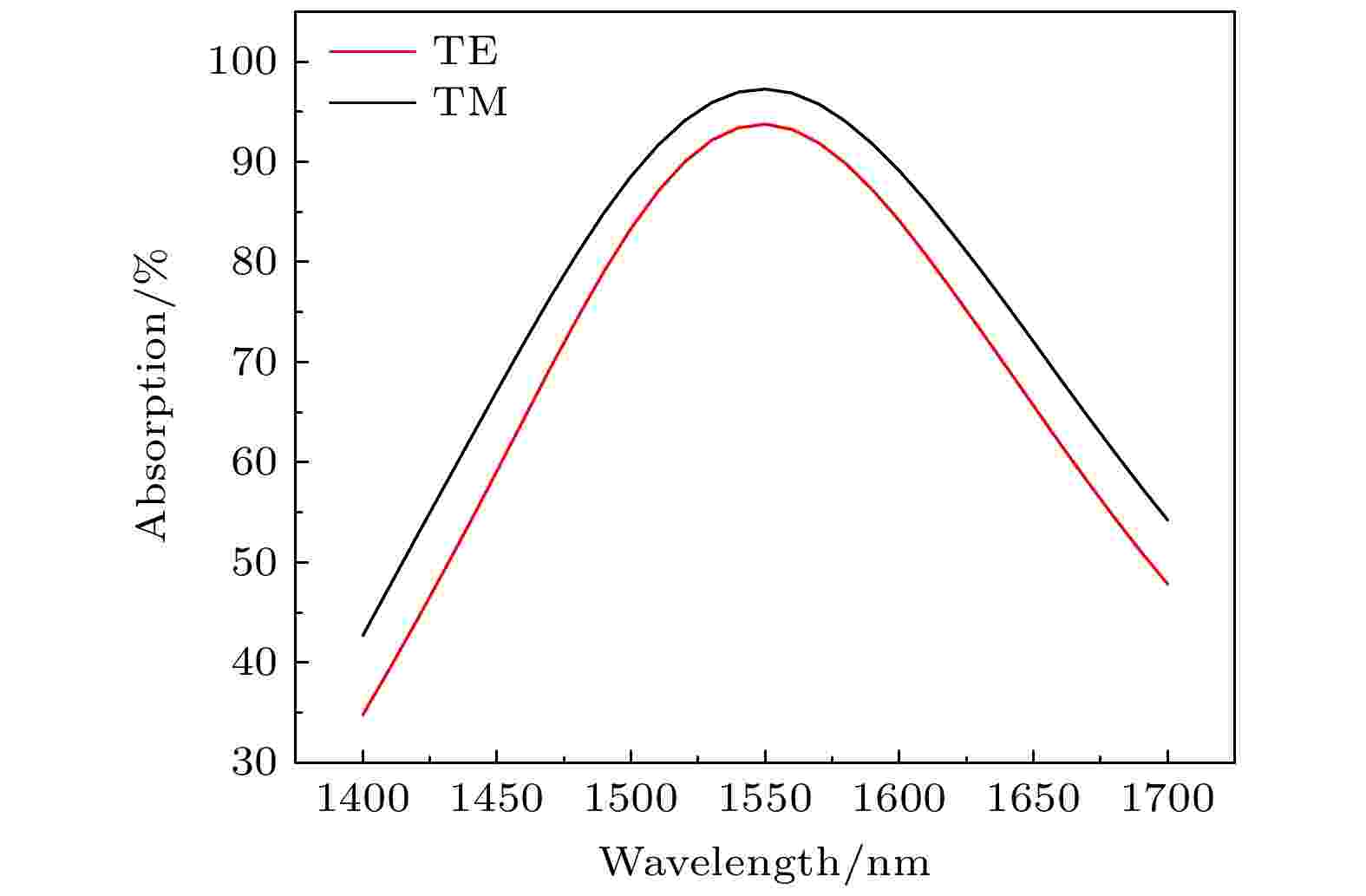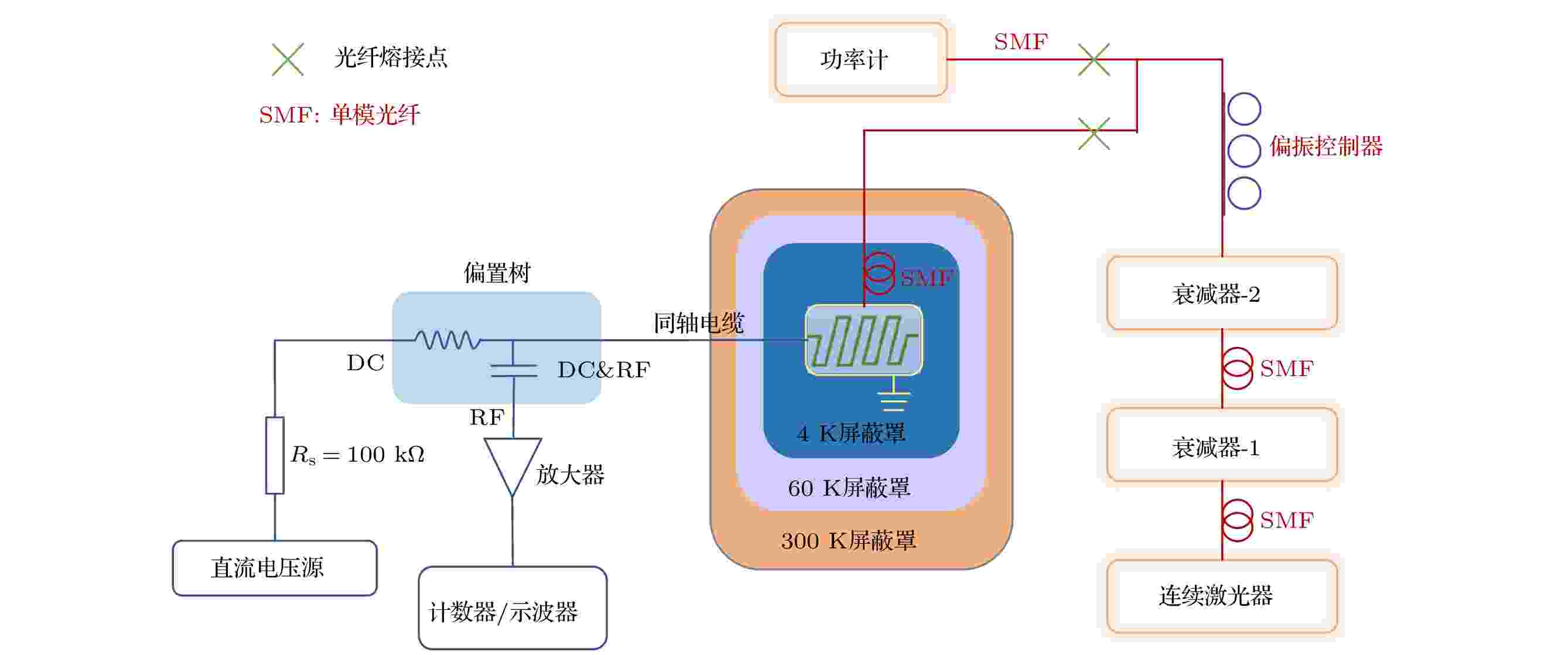全文HTML
--> --> -->与超导转变沿探测器[11]等传统面型结构的单光子探测器相比, SNSPD的核心探测部分是由超薄极窄的纳米线周期性曲折排列构成. 根据Anant等[12]的研究, 这种独特的各向异性回形结构会导致SNSPD对不同偏振态入射光具有不同的光吸收效率: 对于横向电(transverse electric, TE)偏振光, 纳米线有着最大的光吸收效率; 对于横向磁(transverse magnetic, TM)偏振光, 纳米线的光吸收效率最低. 而SNSPD的探测效率一般表示为光吸收效率ηabs、光耦合效率ηcouple和本征效率ηquant三者的乘积. 光吸收效率的偏振相关性直接导致了其探测效率也是偏振相关的. 通常将最大探测效率(SDEmax)与最小探测效率(SDEmin)的比值定义为偏振消光比(polarization extinction ratio, PER), 用于评估SNSPD的偏振敏感性. SNSPD的偏振敏感性限制了其在许多量子通信领域的应用, 比如在基于光子偏振态编码的量子密钥分发中[13], 光子的偏振态在传播过程中会随着时间的推移而发生变化, 如果使用具有偏振敏感性的探测器作为接收端, 将会造成误码率的增大. 而在一些使用多模光纤或自由空间进行光耦合的应用中, 如卫星激光测距[14,15]、深空激光通信[16,17]、远距离单光子飞行时间成像[18]等, 由于偏振敏感性的原因, SNSPD的高探测效率优势将会被大大折损.
目前, 抑制SNSPD偏振敏感性的手段主要可以分为提高纳米线结构的几何对称性和采用高折射率材料包覆纳米线两种方法. 2008年, Dorenbos等[19]首次将纳米线设计为平面相互正交的回形结构与螺旋结构, 其制备的SNSPD的PER为1.1左右, 但是器件的效率极低; 随后Huang等[20]也采用了螺旋线结构的纳米线将器件的PER降低到1.04, 且将SDEmax提升到了52%. Verma等[21]通过将两层非晶WSi材料制备的回形纳米线垂直叠放形成立体结构SNSPD来消除偏振依赖, 相应器件的SDEmax达到了87.7%, 且PER小于1.02. 但因为每层纳米线需要单独制备, 所以很难保证基于NbN等多晶材料的纳米线进行高质量堆叠. 天津大学胡小龙团队[22]利用分形理论将NbN纳米线设计成了高度对称的皮亚诺曲线形状, 采用该结构制备的器件PER为1.1左右, SDEmax为67%. 随后, 为了改善该结构纳米线中的大量拐角导致的电流拥挤效应和进一步提高器件效率, 他们对器件的结构进行了改进[23]: 采用弧形分形拓扑结构取代了原设计中的“U”形拐角和“L”形拐角, 并将基于NbTiN的纳米线设计成并联结构以获取较大的临界电流和较小的时间抖动; 为了进一步提高器件效率, 他们采用了布拉格反射镜和增透膜相组合的结构来提高纳米线的光吸收效率. 尽管结构相对复杂, 但是最终基于该结构制备出的SNSPD不仅具有逼近于1的PER, 且SDEmax被提升到91%.
以上方案都是基于提高纳米线结构的几何对称性来减小入射光偏振态给器件带来的偏振敏感性, 而Xu等[24]基于纳米线内部详细的电磁场分析, 提出使用高折射率Si材料包覆纳米线的方法来提高纳米线对TM偏振态入射光的光吸收效率, 采用此结构制备的器件PER为1.09左右, 同时器件的SDEmax为61%. 该方法通常称为介质补偿法, 具体原理是因为纳米线的光吸收效率与纳米线中的电场强度有关, 对于TM偏振态入射光, 由于其电场方向与纳米线垂直, 当纳米线外侧介质的介电常数相较纳米线小很多时, 场强分布主要集中在纳米线外侧的介质中, 纳米线内部的电场强度很小且分布不均, 从而使纳米线对TM偏振光的吸收效率较低. 因此可以通过介质补偿减小介电常数差异, 提高纳米线内部电场强度, 进而提高纳米线对于TM偏振光的吸收效率, 降低器件的偏振敏感性.
本文沿用传统的回形纳米线结构, 基于介质补偿法设计了一种新型偏振不敏感SNSPD结构, 在引入高折射率Si补偿层补偿纳米线对TM偏振光的吸收效率后(折射率与介电常数正相关), 将补偿层的上表面设计为正弦形亚波长光栅结构, 减小不同波长下纳米线对不同偏振态光子的吸收差异, 以实现一定波长范围内的偏振无关探测, 同时采用了双层纳米线结构和分布式布拉格反射镜来提高纳米线的光吸收效率, 同时达到高探测效率的目标.
2.1.器件设计
图1(a)为本文设计的SNSPD的横截面示意图, 从下到上, 器件分别由400 μm厚的Si衬底、13层Ta2O5/SiO2薄膜组成的分布式布拉格反射镜(distributed Bragg reflector, DBR)、双层纳米线结构、Si补偿层和上表面的正弦形光栅构成. 采用DBR和双层纳米线结构是为了使纳米线具有较高的光吸收效率[4]. 器件按照目标波长为1550 nm所设计, DBR中Ta2O5层和SiO2层的厚度分别为180 nm和268 nm; 双层纳米线结构中每层NbN纳米线的厚度为6 nm, 宽度和周期分别为75 nm和150 nm, 双层纳米线之间采用3 nm厚的SiO2作为绝缘层; 采用高折射率材料Si (n = 3.5)作为介质补偿层覆盖在纳米线侧边及上方. 图 1 (a)采用Si补偿层和正弦形光栅结构的SNSPD横截面示意图, 双层纳米线结构被制备在DBR上; (b)双层纳米线SNSPD光吸收效率随波长变化的仿真结果, 实线代表只叠加Si补偿层的SNSPD, 虚线代表裸纳米线SNSPD
图 1 (a)采用Si补偿层和正弦形光栅结构的SNSPD横截面示意图, 双层纳米线结构被制备在DBR上; (b)双层纳米线SNSPD光吸收效率随波长变化的仿真结果, 实线代表只叠加Si补偿层的SNSPD, 虚线代表裸纳米线SNSPDFigure1. (a) Cross-sectional schematic of the SNSPD with a Si compensation layer and a sinusoidal grating structure, the twin layer nanowire structure was prepared on a DBR; (b) simulated optical absorption as a function of the wavelength of the SNSPD with the twin-layer nanowires, solid lines denote the SNSPD only with a Si compensation layer, and dashed lines denote the SNSPD with bare nanowires.
不同波长下NbN薄膜的折射率采用椭偏仪测得, 在1550 nm处, 与空气(n = 1)相比, Si材料和NbN (n = 4.67–i3.32)之间的介电常数差异被大大降低. 图1(b)为利用有限元软件(Comsol Multiphysics, RF module)进行的不同结构SNSPD对TE和TM偏振光吸收效率随波长变化的数值仿真, 考虑到NbN材料色散效应的影响, 将其折射率作为波长的函数进行了参数设置. 图中虚线为暴露于空气中的裸纳米线SNSPD对应的仿真结果, 实线为叠加Si补偿层但无上表面光栅结构的SNSPD的相应仿真结果. 可以看到叠加Si补偿层后器件对TM偏振光的吸收效率提高到了和TE偏振光吸收效率相当的水平.
在此基础上, 为了使纳米线对这两种偏振光的吸收效率峰值都位于目标波长处, 在补偿层上表面引入了亚波长光栅结构. 由于亚波长光栅尺寸远小于入射光波长, 根据亚波长光栅的等效介质理论, 其对TE和TM偏振态入射光具有不同的等效折射率[25,26], 即对穿过光栅的透射光具有不同的相位调控作用. 通过合理的设计亚波长光栅尺寸, 可以使纳米线在不同波长下对两种偏振态光子的吸收效率都比较接近, 且都在目标波长处存在吸收峰值. 值得注意的是, 为了保证纳米线的质量, 在制备纳米线时, 通常会对其下方的SiO2进行稍微过度刻蚀, 因此在双层NbN纳米线的边缘出现了一个高度至少为15 nm的台阶. 当在该台阶结构上沉积Si补偿层时, 补偿层的上表面会随着纳米线呈现出周期性的正弦形起伏[27]. 结合该实际工艺结果, 采用正弦形的亚波长光栅结构, 在纳米线尺寸一定时, 通过改变纳米线的过刻深度即可改变光栅的高度, 该光栅可在沉积补偿层时自然形成, 无需单独制备, 简化了工艺流程.
为了确定最佳的补偿层厚度和光栅高度, 使用有限元软件进行仿真优化. 仿真发现光栅高度t1和补偿层厚度t 2分别决定了两个吸收峰之间的相对波长差异和吸收峰的绝对位置, 所以分别对每个参数进行优化. 图2实线所示为优化后的器件光吸收效率随波长变化的仿真结果, 此时t1和t 2分别为35 nm和165 nm. 和图1(b)中只叠加补偿层的器件仿真结果相比, 引入正弦形光栅后, 由于光栅对不同偏振光的调控效果不同, TE和TM偏振光的器件吸收效率曲线有明显相对移动的效果, 进而使得两种偏振态入射光的吸收效率峰值较好的重合于目标波长1550 nm处. 此外, 可以看出在1400—1700 nm较宽的波长范围内, 这两种偏振态入射光的器件吸收效率的变化趋势较为一致, 吸收效率的差异始终小于8.5%, PER小于1.22, 即在该波长范围内器件始终是偏振不敏感的, 引入的光栅结构增强了器件的偏振不敏感特性.
 图 2 引入正弦形光栅的偏振不敏感SNSPD光吸收效率随波长变化的仿真结果
图 2 引入正弦形光栅的偏振不敏感SNSPD光吸收效率随波长变化的仿真结果Figure2. Simulated optical absorption as a function of the wavelength of the polarization-insensitive SNSPD with the sinusoidal-shaped grating.
2
2.2.器件制备
依据上述仿真结果, 在400 μm厚的硅片上制备光敏面直径为18 μm的偏振不敏感SNSPD. 首先在Si衬底上交替沉积13层SiO2/Ta2O5薄膜作为四分之一中心波长布拉格反射镜; 在反射镜上依次沉积6 nm厚的NbN薄膜、3 nm厚的SiO2薄膜和6 nm厚的上层NbN薄膜, 其中NbN薄膜采用室温直流磁控溅射法进行制备, SiO2薄膜则采用等离子体增强化学气相沉积法进行制备; 基于上述薄膜结构采用电子束曝光和反应离子刻蚀法制备了双层纳米线结构, 之后通过紫外曝光和反应离子刻蚀法制备电极微桥, 到此基础的器件结构已经成型, 最后为了实现偏振无关探测的效果, 在上述器件顶部采用热蒸发法沉积了一层Si薄膜, 完成了器件制备.图3(a)和3(b)分别为器件的光敏面扫描电子显微镜(scanning electron microscope, SEM)图和展示更多细节的纳米线高度放大SEM图, 从图3(b)可知纳米线的宽度和周期分别为65 nm和150 nm. 图3(c)为器件部分结构的透射电子显微镜(transmission electron microscope, TEM)图, 其中沉积的Si材料总厚度为231 nm, Si补偿层的厚度为187 nm. 图3(d)和图3(e)为高度放大的双层纳米线及正弦形光栅的TEM图. 为了能形成所需的光栅结构, 同时也为了保证上层纳米线的质量, 在采用反应离子刻蚀制备纳米线时, 对过刻的深度进行了控制. 从图3(d)和图3(e)可以看到, 纳米线间隔之间的深度约为6.5 nm, 基于该过刻深度制备的光栅高度为22 nm. 因为纳米线较窄且热蒸发沉积Si补偿层时存在一个蒸发角度, 导致光栅的形状偏离对称性的正弦形结构, 这对光栅的调控作用具有一定的影响.
 图 3 (a) SNSPD光敏面SEM图; (b)高度放大的双层纳米线SEM图; (c) SNSPD横截面TEM图, Si薄膜总厚度约为231 nm; (d)高度放大的双层纳米线TEM图, 过刻深度约6.5 nm; (e)高度放大的正弦形光栅TEM图, 光栅高度为22 nm
图 3 (a) SNSPD光敏面SEM图; (b)高度放大的双层纳米线SEM图; (c) SNSPD横截面TEM图, Si薄膜总厚度约为231 nm; (d)高度放大的双层纳米线TEM图, 过刻深度约6.5 nm; (e)高度放大的正弦形光栅TEM图, 光栅高度为22 nmFigure3. (a) SEM image of the active area of the SNSPD; (b) magnified SEM image of the the twin-layer nanowires; (c) TEM image of the cross-section of the SNSPD with a 231 nm-thick Si film; (d) magnified TEM image of the twin-layer nanowires with an over-etched depth of 6.5 nm; (e) magnified TEM image of the sinusoidal grating with a height of 22 nm.
 图 4 SNSPD测试系统示意图
图 4 SNSPD测试系统示意图Figure4. Schematic of the measurement system used to characterize the SNSPD.
在1465—1630 nm 波长范围内对制备的SNSPD的探测效率和偏振敏感性进行了表征. 图5(a)给出了偏置电流Ib = 0.91Isw时器件的SDEmax, SDEmin和PER的光谱响应, 其中Isw为临界电流. 可以看出, 该器件在1605 nm波长处存在最大的探测效率, 在1505—1630 nm波长范围内, SDEmin都超过了50%, SDEmax和SDEmin之间的差异小于11.5%, PER小于1.2. 最大探测效率对应的波长与设计值1550 nm之间的偏差可以认为是由光栅形状的偏移以及尺寸与折射率的差异造成的, 除此之外, 非理想的器件制备工艺和光学耦合也会导致器件光吸收效率的降低. 作为对比, 在同样的电流偏置下, 还对采用80 nm宽裸纳米线的SNSPD进行了PER的表征(见图5(a)插图). 可以看到, 对没有采取任何抑制偏振敏感性手段的SNSPD, 其PER随波长变化显著, PER最小也大于2, 若采用更窄纳米线, 该PER值会变得更大. 该结果证明了本文器件可以实现一定波长范围内的高效偏振无关探测.
 图 5 (a)偏振不敏感SNSPD的SDE光谱响应, 插图显示了偏振不敏感SNSPD和裸纳米线SNSPD的PER光谱响应对比; (b)偏振不敏感SNSPD在1605 nm处探测效率随偏置电流变化的曲线
图 5 (a)偏振不敏感SNSPD的SDE光谱响应, 插图显示了偏振不敏感SNSPD和裸纳米线SNSPD的PER光谱响应对比; (b)偏振不敏感SNSPD在1605 nm处探测效率随偏置电流变化的曲线Figure5. (a) Spectral responses of SDE for the polarization-insensitive SNSPD, the inset shows a comparison of the spectral responses of PER for the polarization-insensitive SNSPD and the SNSPD with bare nanowires; (b) system detection efficiency curves as a function of the bias current at 1605 nm for the polarization-insensitive SNSPD.
图5(b)为1605 nm波长下器件探测效率随偏置电流的变化, 在DCR为100 Hz时, SDEmax为87%, SDEmin也达到了82%, 对应的PER为1.06. 在整个探测光谱范围内, 器件的效率曲线都存在一段饱和区间, 即器件的本征效率为100%. 在保证器件本征光子响应饱和的前提下, 还可以适度加大纳米线的宽度, 进一步提高探测效率的同时还可以降低PER值.
